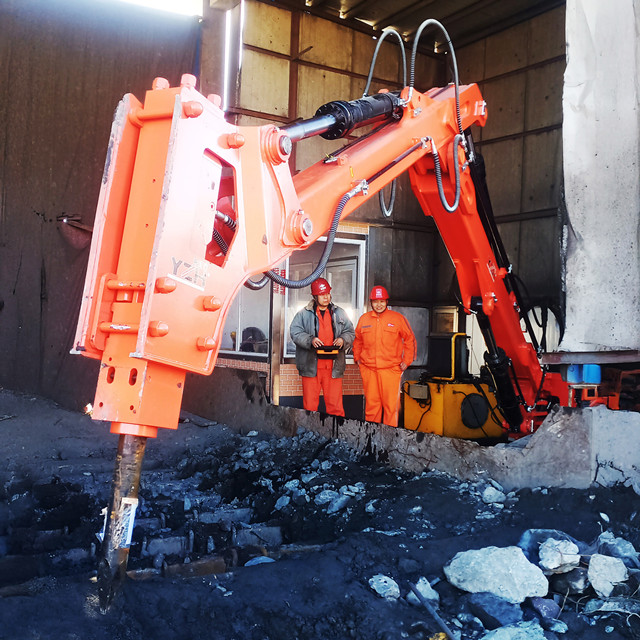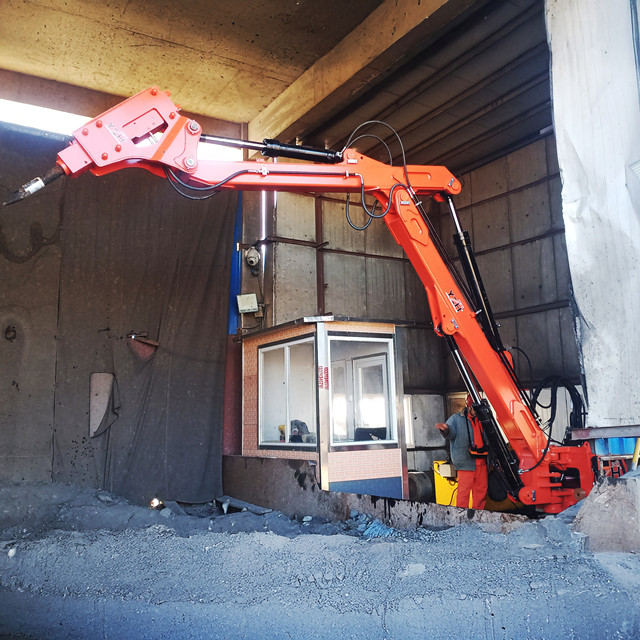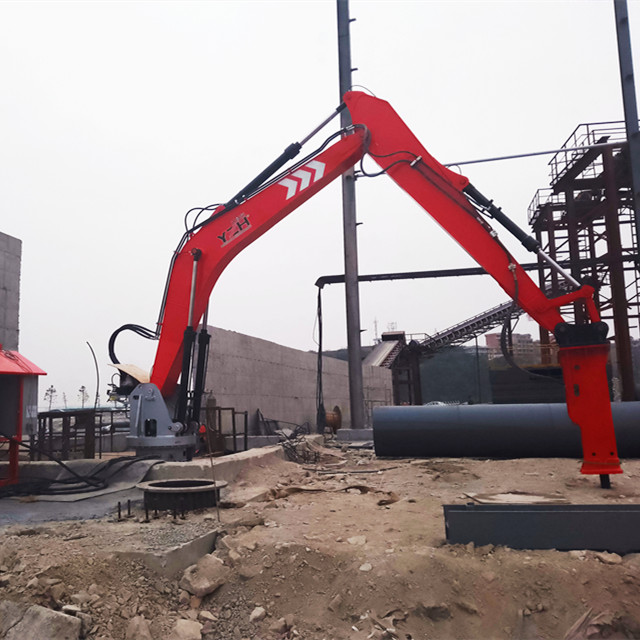
By Kevin
So I'm at a trade show last month, right? This guy walks up to our booth, looks at our biggest pedestal boom system, and goes "Man, that thing's impressive. I need one of those."
I ask him what he's crushing. "Oh, maybe 50 tons a day of concrete recycling."
I had to laugh. That's like buying a Mack truck to haul groceries.
Look, I sell these systems for a living, but I'm not going to BS you. Most operations don't need a pedestal boom. They're expensive, they're overkill for small jobs, and frankly, a lot of people buy them for the wrong reasons.
But when you DO need one? When the economics actually make sense? They're absolute game changers.
Let me tell you about the places where these things actually earn their keep.
Mining: Where This All Started
I've been doing this for over 20 years now, and mining is still where we sell most of our big systems. There's a reason for that.
The Real Deal
I was at a copper mine in Arizona couple years back. Their primary crusher handles something like 4,000 tons an hour. When that thing jams - and it jams maybe twice a day - they're bleeding money. Fast.
Their old process? Call the mobile guy, wait for him to drive over from wherever he was, get positioned, deploy the outriggers, clear the jam. Whole thing took 45 minutes on a good day. Hour and a half if the mobile unit was working somewhere else on site.
Do the math. 4,000 tons an hour, copper prices where they are... that's serious money.
We put in an 18-meter boom. Same jams now clear in 10-12 minutes. The mine superintendent told me it paid for itself in six months. I believe him.
Underground is a Different Animal
Surface mines are easy. Plenty of room, good access, stable ground. Underground? That's where things get interesting.
I remember this gold mine in Nevada. Crusher was 800 feet down. To get their mobile unit underground, they had to take it apart piece by piece, lower it down the shaft, reassemble it. Took two days. Then you've got diesel exhaust in a confined space, ventilation issues, the whole mess.
We lowered our boom down in sections, bolted it together, plugged it into their electrical system. Done. Clean, quiet, no fumes. The mine boss said it was the smartest thing they'd done in years.
Different Mines, Different Problems
Iron ore guys are our bread and butter. Massive volumes, consistent material, they run like clockwork. Perfect fit for pedestal booms.
Coal is trickier because of all the safety regs around electrical equipment. But when you can use them, they're great - no diesel exhaust where air quality is already a concern.
Gold operations surprise people. You think small scale, but some of these modern gold mines are huge. And when you're processing ore worth thousands per ton, every minute counts.
Quarries: The Sleeper Market
People always think mining when they think pedestal booms. But honestly? Some of my best installations are in quarries.
Limestone Will Fool You
Had this limestone quarry in Ohio. Limestone seems soft, right? Wrong. It's abrasive as hell, and when it jams, it packs together like concrete.
They were spending hours every day clearing jams manually. Guys climbing into the crusher with pry bars and sledgehammers. Dangerous as hell. Their insurance company was having fits.
Put in a boom system. Same jams that used to take hours now clear in minutes. But the real win? Nobody's climbing into that crusher anymore. The safety guy told me it was worth the investment just for that.
Recycled Concrete is Nasty
More quarries are processing recycled concrete these days. Good for the environment, hell on equipment. Concrete chunks with rebar, wire mesh, all kinds of metal junk mixed in.
Regular equipment chokes on this stuff. But a boom can carefully pick out the problem pieces without trashing the crusher. Seen operations double their recycled processing just by adding a boom.
Seasonal Operations
Lot of quarries are seasonal - busy spring through fall, dead in winter. For these guys, mobile equipment sometimes makes more sense because they can use it for other stuff in the off-season.
But the big quarries that run year-round? Boom systems usually win. The reliability matters more than flexibility when you're moving thousands of tons a day.
Cement Plants: The Precision Game
Don't see much about cement plants in our marketing stuff, but they're actually perfect for booms.
Chemistry Matters
Cement production is all about precise ratios. The limestone and other raw materials have to be exactly the right size. When you're manually breaking jams with hammers, you're messing with the size distribution. The plant chemists hate that.
Booms give you control. Clear the jam without creating a bunch of fines or damaging good material. Keeps the feed consistent.
Never Stop Running
Most cement plants run 24/7. Worked with a plant in Texas that hadn't shut down their kiln in three years except for scheduled maintenance. When the raw material crusher jams, it backs up the whole line.
Plant manager told me crusher jams used to be their biggest headache. Now they clear them so fast the downstream equipment barely notices.

Steel Mills: The Tough Guys
Steel mills are probably the nastiest environment we work in. Hot, dirty, corrosive. Materials that would kill regular equipment.
Scrap is Crazy
Modern steel uses tons of recycled scrap. Car bodies, appliances, I-beams, wire - all mixed together. When the scrap crusher jams, it's usually a tangled mess.
Worked with a mill in Pennsylvania. They were using mobile equipment, but positioning was always a problem. Couldn't get the right angle to separate tangled stuff.
Boom solved it. 360-degree rotation, precise positioning. Instead of just hammering away, operators could strategically separate materials.
Clean Operation
Steel mills have strict environmental rules. Diesel exhaust from mobile equipment can be a problem, especially indoors.
Electric booms eliminate that. Clean operation, no emissions. Can tie into the plant's monitoring systems.
Waste Processing: The Growth Story
This is probably our fastest-growing market. Waste processing has exploded as landfill costs went through the roof and recycling requirements got stricter.
Municipal Waste is Chaos
Processing municipal waste is like playing whack-a-mole. Never know what's going to jam your crusher. Furniture, appliances, bundled stuff.
Had a facility in California spending half their day clearing jams. Mobile equipment was constantly moving around for different jam types.
Boom gave them the reach and flexibility to handle everything from one position. Game changer.
Construction Debris Pays
C&D waste processing is big business now. Concrete, asphalt, wood, metal - all valuable if you can separate it right.
Problem is C&D waste comes in weird combinations. Concrete chunk might have rebar, conduit, wood all mixed in. Need to carefully extract the good stuff without contaminating it.
Booms are perfect for this. Instead of just breaking everything smaller, operators can selectively separate materials. Maximizes recovery value.
The Surprises
After 20 years, I still get surprised by new applications.
Biomass Plants
Renewable energy facilities processing wood chips have become big customers. Those materials jam just like rock.
Had a biomass plant in Oregon with constant wood chip crusher problems. Fibrous material created jams that were hell to clear.
Boom with specialized attachment solved it. Plant manager said it made the difference between profit and loss.
Food Waste
Big food processors generate tons of organic waste that needs size reduction. Fruit pits, nut shells - tougher than you'd think.
Stainless steel booms for food-grade applications opened up this market. Small niche, but growing fast.
When Does It Actually Make Sense?
After all these years, I can usually tell in five minutes whether someone needs a boom.
Volume is Key
Under 500 tons a day? Probably overkill. Economics don't work unless you've got other factors like safety concerns or crazy expensive downtime.
Over 1,000 tons a day? That's where booms start making sense. Time savings add up fast at high volumes.
What's Downtime Cost You?
I always ask what an hour of crusher downtime actually costs. If they can't answer, they probably don't need a boom.
But when someone says $10,000 an hour, I know we're doing business.
How Often Do You Jam?
Once a month? Mobile equipment is fine. Daily jams? Multiple times a day? Now we're talking boom territory.
Break-even is usually around one jam per week. Above that, time savings add up quick.
The Honest Truth
Here's what I tell people: most operations don't need these things.
Small quarry processing a few hundred tons a day with occasional jams? Stick with what you've got. The numbers won't work.
But high-volume operation where crusher uptime directly hits your bottom line? Booms can be transformational.
Key is being honest about what you actually need. Don't buy a boom because it looks cool at trade shows. Buy it because it solves a real problem that's costing you money every day.
The Sweet Spot
Operations that benefit most usually:
Process over 1,000 tons daily
Jam at least weekly
Lose $5,000+ per hour of downtime
Have safety concerns with manual clearing
Need consistent product quality
Check most of those boxes? Let's talk. Don't? You're probably better off with other solutions.

What's Coming
Industries using booms keep expanding. Twenty years ago it was mostly mining and some quarries. Now we're in waste plants, biomass facilities, recycling operations.
What's driving it? Safety focus, environmental regs favoring electric equipment, more complex materials being processed.
Expect more growth in waste and recycling as circular economy requirements increase. Battery recycling is already emerging as EV adoption accelerates.
But fundamentals stay the same - booms make sense for high-volume operations where uptime is critical and safety matters.
Still not sure? Contact us now. After 20 years of this, I can usually tell you pretty quick whether it makes sense for your situation.
Kevin Chen
YZH Machinery















